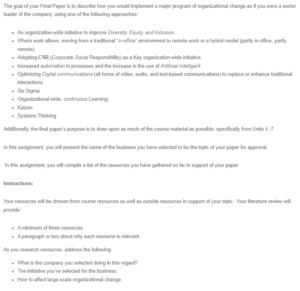Automation and the Use of Artificial Intelligent Systems in the Retail Sector
The retail industry is gradually embracing technology to improve efficiency in the supply chain. According to Grandhi (2021), the technologies applied in the retail sector have evolved. Retail companies are using smart tag technologies such as point of sale, radio frequency identification, advanced customer relationship management, and enterprise resource planning software. Radiofrequency identification is used to identify features such as proper billing before the product is delivered to a customer. Point of sale records transaction codes for future reference and tracking sales (Grandhi, 2021). The rise of advanced customer relationship management and enterprise resource planning software is embraced to help retailers leverage the efficiency of technology in maintaining contact with customers to address customer issues within the shortest time possible (Grandhi, 2021). Automation is also used to integrate departmental data in retail stores and maintain it so that it can be easily retrieved for decision-making.
According to Cao (2021), organizations in the retail sector are also embracing the use of artificial intelligence to remain relevant in the rapidly growing e-commerce sector. The authors argue that algorithms and data are vital to evolving business models for retailers to predict the future and accurately prepare for challenges and opportunities. Retailers are also leveraging artificial intelligence to make decisions because artificial intelligence is fed with information that can be used to combine consumer activities and retail transactions (Cao, 2021). Retailers can also access the free data provided by consumers to improve their processes and create a competitive advantage. The data is mainly collected when customers buy a product, talk about products on online platforms, and browse a product online (Cao, 2021). Therefore, the use of artificial intelligence is a promising move for retailers seeking market share expansion because it improves customer relationship management and creates a better understanding of consumer needs and preferences.
Artificial intelligence in the retail sector has extended to inventory management, whereby retailers use artificial intelligence to predict demand, maintain popular items in stock, and predict future customer needs. According to Spanke (2020), deep learning, machine learning, and intelligent applications can be used to match demand and supply by using a wide range of data sources and adjusting demand based on supply. Retailers are also using predictive inventory management to improve the accuracy of demand and supply forecasts and optimize the inventory throughout the value chain in retail companies resulting in increased cost-savings and profits. However, the backbone of applying artificial intelligence in inventory management is proper knowledge management throughout the value chain by using, sharing, managing, generating, and processing information (Spanke, 2020). The main objective is to generate insights and knowledge supporting all activities in the value chain.
Oosthuizen et al. (2020) argue that the appropriate application of artificial intelligence results in responsive research and development, widespread transactional data processing, and dynamic price recommendations. By gathering and analyzing data across different sources, artificial intelligence applications can predict future consumer and product needs, creating a competitive advantage. Customer engagements facilitated by artificial intelligence include various functions directed towards augmenting customer interactions and building strong customer relationships. Such functions include supporting customers in viewing items in a retail store, responding to questions, and creating personalized recommendations for pouts in the stores (Oosthuizen et al., 2020). Organizations in the retail sector may also leverage artificial intelligence to navigate the stages in value chains in the manufacture, design, distribution, commercialization, and support of items offered in online and physical stores, hence connecting with customers.
References
Cao, L. (2021). Artificial intelligence in retail: Applications and value creation logics. International Journal of Retail & Distribution Management, ahead-of-print(ahead-of-print). https://doi.org/10.1108/ijrdm-09-2020-0350
Grandhi, R. B. (2021). The role of IT in automating the business processes in the retail sector with reference to Enterprise resource planning. International Journal of Business and Management Research, 9(2), 190-193. https://doi.org/10.37391/ijbmr.090209
Oosthuizen, K., Botha, E., Robertson, J., & Montecchi, M. (2020). Artificial intelligence in retail: The AI-enabled value chain. Australasian Marketing Journal, 29(3), 264-273. https://doi.org/10.1016/j.ausmj.2020.07.007
Spanke, M. (2020). Artificial intelligence. Retail Isn’t Dead, 55-62. https://doi.org/10.1007/978-3-030-36650-6_7
ORDER A PLAGIARISM-FREE PAPER HERE
We’ll write everything from scratch
Question

Automation and the Use of Artificial Intelligent Systems in the Retail Sector
Overview:
The goal of your Final Paper is to describe how you would implement a major program of organizational change as if you were a senior leader of the company, using one of the following approaches:
- An organization-wide initiative to improve Diversity, Equity, and Inclusion.
- Where work allows, moving from a traditional “in-office” environment to remote work or a hybrid model (partly in-office, partly remote).
- Adopting CSR (Corporate Social Responsibility) as a Key organization-wide initiative.
- Increased automation in processes and the increase in the use of Artificial Intelligent
- Optimizing Digital communications (all forms of video, audio, and text-based communications) to replace or enhance traditional interactions.
- Six Sigma
- Organizational-wide, continuous Learning
- Kaizen
- Systems Thinking
Additionally, the final paper’s purpose is to draw upon as much of the course material as possible, specifically from Units 5 -7.
In this assignment, you will present the name of the business you have selected to be the topic of your paper for approval.
In this assignment, you will compile a list of the resources you have gathered so far in support of your paper.
Instructions:
Your resources will be chosen from course resources as well as outside resources in support of your topic. Your literature review will provide:
- A minimum of three resources.
- A paragraph or two about why each resource is relevant.
As you research resources, address the following:
- What is the company you selected doing in this regard?
- The initiative you’ve selected for the business.
- How to affect large-scale organizational change.

